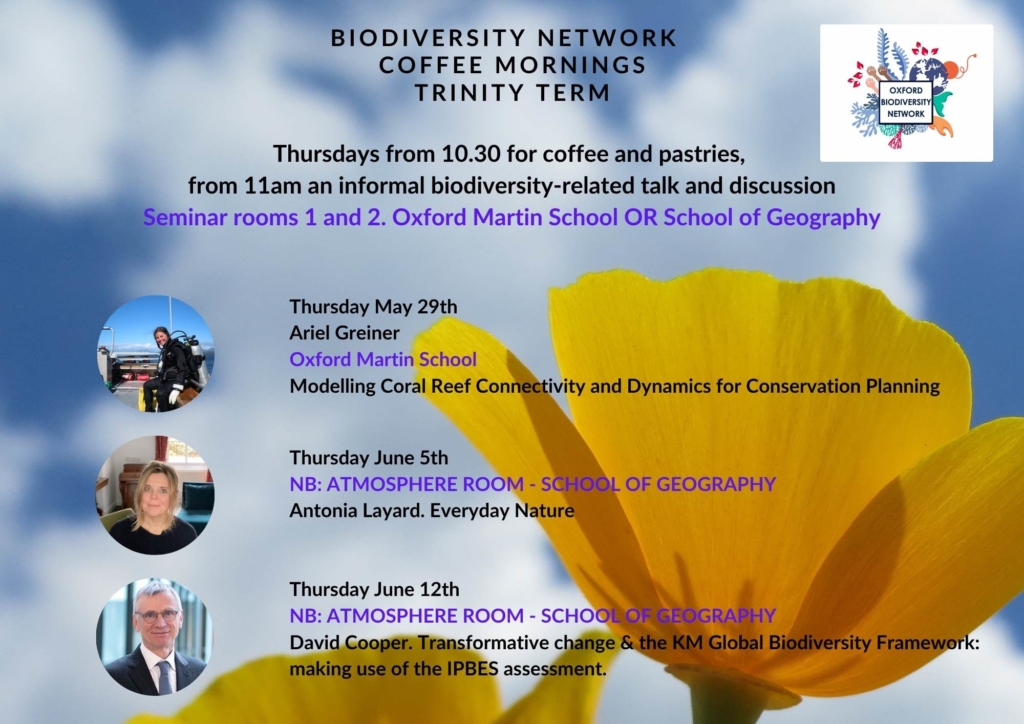Biodiversity Network Coffee Mornings – Trinity Term

8th May: GLAM and biodiversity: Partnering for a sustainable future – Jon Ray
The Gardens, Libraries, and Museums (GLAM) have set a biodiversity net gain target in line with the University’s goals. GLAM occupies over 50 buildings across Oxford, cares for over 21 million objects, specimens, and printed items, and receives over 3.5 million visitors annually. Initial work has been undertaken to develop a biodiversity footprint and build an action plan. Jon will discuss the findings so far and share the draft action plan. GLAM is keen to explore partnerships with researchers to target and take action to reduce our footprint. In particular, they are interested in how GLAM could act as a ‘living laboratory’ for researchers to explore the real-life impacts of different initiatives.
15th May: Lobbying for nature: What’s new since Brexit? – Nathalie Berny
The UK decision to leave the EU following the 2016 referendum vote has triggered a prolonged period of uncertainty and fundamental change for both environmental legislation and governance. The repatriation of this devolved competence has entailed a risk of divergence in terms of policy ambition and possibilities of enforcement. For environmental NGOs, trying to shape post-Brexit policies has been a monumental task. The sequence from the Brexit vote to the most recent developments in Scotland and Wales offers a fascinating case to study lobbying for nature in new and unprecedented and conditions. Drawing from the literature on interest groups and policy entrepreneurship, I explore the NGOs’ successful attempt to revive a former proposal to legislate in the protection of the natural environment — with a framework of legally binding targets — and its policy journey in England, Scotland and Wales.
This presentation is part of a research project hosted by the Maison France on environmental NGOs and turbulence.
22nd May: Exploring the status and future of Scotland’s Caledonian pinewoods – Emily Warner
Scotland’s once extensive Caledonian pinewoods now cover less than 1% of the Scottish Highlands. Working with NGO Trees for Life’s Caledonian Pinewood Recovery Project dataset, collected across 72 pinewood remnants, we explore trends in the composition and future sustainability of these forests, and how browsing impacts from deer are shaping this.
29th May: Modelling Coral Reef Connectivity and Dynamics for Conservation Planning – Ariel Greiner
Coral reefs are connected together by long-distance larval dispersal and can exist in multiple stable states (coral-dominated, seaweed-dominated, etc.). In this presentation, I demonstrate how mathematical modelling allows us to generate hypotheses as to how both of those aspects of coral reef systems might impact large-scale and long-term management of reef systems and present specific case studies.
5th June: Antoina Layard. Everyday nature.
NB WE WILL BE MEETING IN THE ATMOSPHERE ROOM IN THE SCHOOL OF GEOGRAPHY TODAY
English planning and environmental law and policy inadvertently distinguishes between nature and biodiversity. While this distinction may better protect ‘priority’ habitats and species, such legislative and scientific classification often excludes human access and wellbeing, which is often treated as a mere ‘co-benefit’. By contrast, ‘everyday nature’, that foregrounds the importance of nearby, accessible green and blue spaces for ecological and human health, is poorly protected in the current planning framework.
12th June: David Cooper. Transformative change and the KM Global Biodiversity Framework: making use of the IPBES assessment.
NB WE WILL BE MEETING IN THE ATMOSPHERE ROOM IN THE SCHOOL OF GEOGRAPHY TODAY
David will provide a brief introduction to the Thematic Assessment Report on the Underlying Causes of Biodiversity Loss and the Determinants of Transformative Change and Options for Achieving the 2050 Vision for Biodiversity of the Intergovernmental Science-Policy Platform on Biodiversity and Ecosystem Services, present-some linkages to the Kunming Montreal global biodiversity framework and open a discussion on how Oxford may promote interdisciplinary nand transdisciplanry work to promote transformative change. Please come with your ideas!





